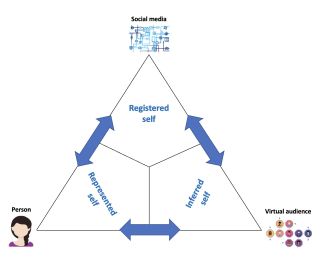Social Media
Our Three Selves in the Age of Social Media
The self is not just in our mind but out in the wild of the World Wide Web.
Updated February 2, 2024 Reviewed by Davia Sills
Key points
- People have multiple identities: who they think they are, how they self-present, and how others see them.
- In the age of the internet, people form their identities through what they put online and how they post it.
- The reactions of other social media users play a critical role in online identity formation.
We have three selves in the age of social media: who we think we are, how we present ourselves online, and what other social media users think of us.
The Represented Self
Through our experiences and our interactions with others and the world around us, we develop a sense of who we are: things we like (e.g., reading, cooking, hiking), our personal characteristics (e.g., smart, funny, outgoing), our important relations at home and work, and our social identities (e.g., profession, political affiliation, religion). I call this self the represented self. It is how we privately view ourselves. The rudimentary form of the represented self emerges at around the end of the second year of life when babies start to be able to recognize themselves in the mirror. The represented self becomes increasingly rich and complex as we continue to experience the world, and it, in turn, shapes our experience and behavior.
The Registered Self
With the omnipresence of social media, we post online about our views and experiences as our lives unfold, we share information that we think may be useful or interesting to others, and we repost, like, and comment on others’ posts. We do this primarily to express ourselves and to feel socially connected. We may also post online to persuade, to inform, or to seek advice or sympathy.
Through our online activities, we acquire a digital extension of who we are, which I refer to as the registered self. It is how we present ourselves to others in the open, public sphere of social media platforms. The registered self is the represented self coming out through a filter, often reflecting how we would like others to view us. As a result, we tend to be selective in terms of what we share, such as more positive than negative, more important than mundane, more interesting than lame, and so on, as well as how we share the information, such as being authentic, self-revealing, and uplifting.
What and how we share our experiences later becomes how we remember and tell our life stories. The registered self is in flux as we adjust what and how we post based on the feedback of our audience: We continue to pose similar things when our posts receive many likes and comments, and we shift topics when our posts elicit no response. By making short, frequent, and real-time posts of "what I'm doing now" and receiving immediate reactions from our audience, we feel a sense of constant connection with others, no matter how fleeting that feeling may be.
The Inferred Self
Do our fellow social media users actually get who we are from our posts and other online activities? Unless we have a personal profile clearly describing the kind of people we are, that information is not readily available to our audience. In other words, other social media users do not have direct access to our private represented self; all they see is our registered self that is permeated through our online activities.
Then comes what I call the inferred self, where our audience forms an impression of who we are based on our social media posts and through their interaction in various ways with our posts. Because our posts are often scattered pieces of information about what we did or what we think without an apparent logical link among them, our audience must connect the dots to reach an understanding of who we are. As a result, discrepancies can occur such that other social media users do not necessarily see us the way we see ourselves. They may not think of us as outgoing or of high self-esteem as we think we are, for example.
Using multi-media tools (e.g., pictures, videos, links) in our posts helps to convey more information about us and allows our audience to infer more accurately who we are. The inferred self is being updated as we continue engaging with our audience through our posts and other activities. It can influence how others interact with us online and, in turn, how we present ourselves online and view ourselves privately.
Conclusion
Our three selves are interrelated components of a dynamic selfhood unique to the social media era. They encompass self-authenticity, they are socially grounded, and they are sustained by technological tools. Understanding the intricacies of our sense of self helps us effectively navigate the digitally mediated world.
References
Wang, Q. (2022). The triangular self in the social media era. Memory, Mind & Media, 1, E4, 1-12. https://doi.org/10.1017/mem.2021.6
Wang, Q., Khuu, A., & Jivotovski, M. (2023). The self online: When meaning-making is outsourced to the cyber audience. PLoS ONE, 18(12): e0294990. https://doi.org/10.1371/journal.pone.0294990
Wang, Q., Lee, D., & Hou, Y. (2017). Externalizing the autobiographical self: Sharing personal memories online facilitated memory retention. Memory, 25, 6, 772-776. doi: 10.1080/09658211.2016.1221115



